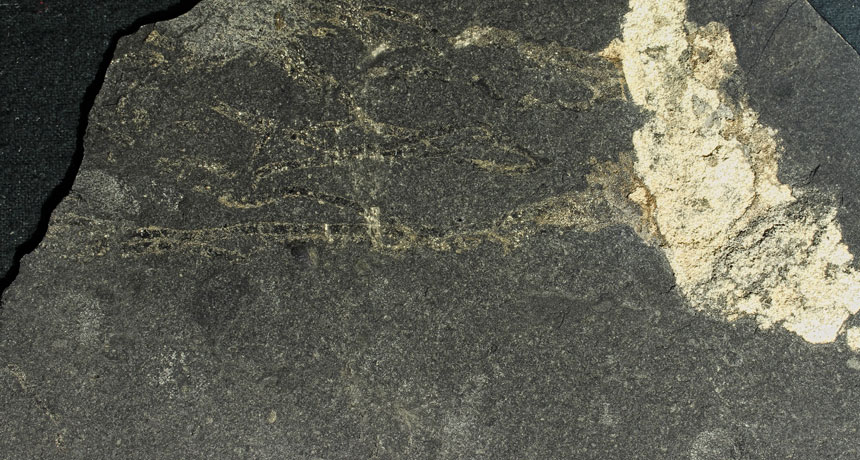Ancient jellyfish died a strange death
Oddball fossil hints at unusual series of events that led to animal’s preservation

More than 300 million years ago, a peculiar series of events ended in the fossilization of this jellyfish. Only recently have scientists unraveled the full story, four decades after the fossil turned up in an Indiana quarry.
G. YOUNG
Share this:
- Share via email (Opens in new window) Email
- Click to share on Facebook (Opens in new window) Facebook
- Click to share on X (Opens in new window) X
- Click to share on Pinterest (Opens in new window) Pinterest
- Click to share on Reddit (Opens in new window) Reddit
- Share to Google Classroom (Opens in new window) Google Classroom
- Click to print (Opens in new window) Print
VANCOUVER — There’s nothing too unusual about a beached jellyfish — unless it happened to wash ashore 310 million years ago.
Such an ordinary occurrence on a beach long, long ago kicked off a peculiar sequence of events. It ended with the creation of an oddball fossil. It looks like a blob of white sand encased in black rock — except that this blob has tentacles.
The fossilized jellyfish was found in an Indiana quarry in 1973. Only recently did Graham Young and another expert reconstruct the ancient animal’s bizarre final moments. Young is a paleontologist at Canada’s Manitoba Museum in Winnipeg.
The jellyfish was about the length of a smartphone. It became stranded on a prehistoric beach, Young thinks. As the jellyfish struggled to free itself, it pumped its boxy body. Instead of water, the body filled with sand.
Soon after, a storm or large wave lifted the dead, sand-filled jellyfish off the beach. It ended up in a lagoon. There, the jellyfish sank to the muddy bottom. Over time, the surrounding silt and clay hardened into black shale. Trapped inside was the jellyfish and its load of sand.The jellyfish’s multistep preservation could help explain how unusual sand patches get embedded in rock formations typically free of sand, Young said. He presented his team’s findings October 21 in Canada at the annual meeting of the Geological Society of America. This year’s meeting was held in Vancouver, British Columbia.
Power Words
clay Fine-grained particles of soil that stick together and can be molded when wet. When fired under intense heat, clay can become hard and brittle. That’s why it’s used to fashion pottery and bricks.
fossil Any preserved remains or traces of ancient life. There are many different types of fossils: The bones and other body parts of dinosaurs are called “body fossils.” Things like footprints are called “trace fossils.” Even specimens of dinosaur poop are fossils. The process of forming fossils is called fossilization.
geological Having to do with the study of Earth’s physical structure and substance, its history and the processes that act on it. People who work in this field are known as geologists.
jellies (in biology) These are gelatinous animals that drift in water (mostly seawater) or brackish (semi-salty) estuaries. For more than 500 million years, they have moved around the oceans by pumping pulses of water through their jelly-like tissue. Their body often has an umbrella-shaped bell. Trailing from inside it may be many tentacles. Although jellies don’t have brains, they do have a nervous system which can sometimes detect light, movement or certain chemicals. Some members of this family are known as jellyfish. In fact, none are true fish.
lagoon A small body of seawater — usually fairly shallow water — that’s cut off from the open ocean by a sand bar, coral reef or narrow strip of land.
paleontology The branch of science concerned with ancient, fossilized animals and plants.
shale A fine-grained sedimentary rock made by compressing layers of clay-rich sediment for millions of years.
silt Very fine mineral particles or grains present in soil. They can be made of sand or other materials. When materials of this size make up most of the particles in soil, the composite is referred to as clay. Silt is formed by the erosion of rocks, and then usually deposited elsewhere by wind, water or glaciers.







